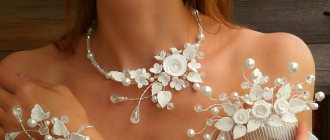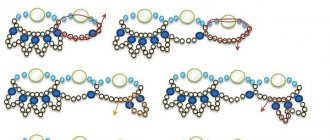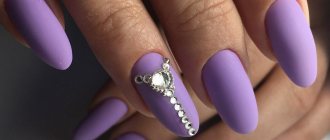Home » Holidays » Beaded wedding bouquets - a masterpiece for a special occasion
HolidaysFlowers
Irina Vyshivaikina 07/09/2019
1
The bride wants to be the most beautiful on such a wonderful holiday. Many try to come up with an original image that no one has had before. Masterly hairstyles, unusual outfits and, of course, many variations on the theme of the bouquet are used. Artificial bouquets at weddings are no longer uncommon, but more recently a beaded bridal bouquet to match the outfit has come into fashion.
Beaded wedding bouquet
Advantages
For those who are considering the option of a wedding bouquet made of beads, here are several advantages:
- the bouquet will not wither and will remain a memorable souvenir of your wedding for a long time. And if memories suddenly come flooding back, you can always hold it in your hands and feel the emotions from the past;
- The color of the beads can be matched to the dress. The color palette is so diverse that any idea can be realized using this material;
- flowers can be made of any size and shape. You don’t have to start from real flowers, you can use your imagination and create something magical;
- Beaded flowers practically do not differ in weight from real flowers. But unlike real ones, beaded flowers cannot be torn or crushed;
- This bouquet is not at all afraid of weather conditions. It tolerates heat, cold and rain well. You can also apply a drop of your favorite scent to complete the look of a romantic bride;
- With the help of beads you can fit the bouquet into the image of the bride. The materials used both in the dress and in the bouquet look interesting;
- With such a bouquet, all eyes will be focused on the bride. Originality is highly valued in the modern world;
- Rainbow tints in the sun look spectacular. With the right angle, you can get fabulous photos.
Lack of wicker accessories
Despite all the originality and practicality of such a bouquet, it has its drawbacks:
- You will have to fork out some money for such a bouquet; handmade work is not cheap;
- When weaving a bouquet yourself, you need to spend a lot of time;
- It will not be easy for beginners to create a whole wedding bouquet;
- The bridesmaids will have to give up the fun tradition of throwing a bouquet or purchase a separate bouquet for this purpose.
Flowers made of beads. Bride. Master class with step-by-step photos
I want to share the creation of this beautiful flower “Bride”
I want to share the creation of this beautiful flower “Bride”
The photo shows that there are from 7 to 11 flowers on one stem. I wove 7 flowers. For this you will need: - wire No. 3 green or steel color (I have not seen white in our stores for sale) - beads - white (in the future I will denote it with the letter “b”), green (“z”), a little yellow and light green with a hint of mustard - plaster or alabaster - green silk threads or floss (embroidery threads) - strips of green corrugated paper - 4 pieces of wire 1mm thick and 30cm long - PVA glue
To create such a composition, we will also need a container for planting a flower (preferably white) - beads, beads, pieces of steel-colored wire For one flower we will need: 3 small petals, 2 medium and 2 large.
All petals are made in parallel weaving.
One small petal will require 25 cm of wire and it is woven according to the pattern 1b-2b-1b1z1b-2b1z2b-2b2z2b-2b2z2b-2b1z2b-1b1z1b-1b. (1-2-3-5-6-6-5-3-1) One middle petal will require 35cm of wire and is woven according to the following pattern 1b-2b-1b1z1b-1b3z1b-2b2z2b-2b2z2b-2b3z2b-2b3z2b-2b2z2b-2b2z2b -1b3z1b-1b1z1b-1b (1-2-3-5-6-6-7-7-6-6-5-3-1) One large petal requires 45cm of wire and is woven according to the pattern 1b-2b-1b1z1b- 1b2z1b-2b2z2b-2b4z2b-2b5z2b-2b5z2b-3b4z3b-3b4z3b-2b4z2b-2b2z2b-1b2z1b-1b1z1b-1b (1-2-3-4-6-8-9-9-10-10-8-6-4- 3-1) For the middle of the flower we need to collect 3 stamens in the form of 3 small flowers.
String 1 yellow bead onto the tip of the wire. Place it in the center of the mustard bead ring so that there are three mustard beads to the left and right of the wire. Squeeze the yellow bead onto the other side of the ring and pass the wire through it in the opposite direction.
Let's take a wire, 25 cm long, string 5 white beads, pass one end of the wire through the first bead to make a loop. You need to make 5 such loops. We collect a small flower (stamen) - insert the mustard-colored center into the white center and twist the wire.
Now let's start assembling the flower: twist 3 small flowers (stamens) tightly together and wrap them tightly with 4-5 mm threads. Down
Then, in a checkerboard pattern, we begin to attach our petals with threads, starting with small ones, around the stamens.
The remaining ends of the wire were tightly twisted together and wrapped with a strip of corrugated paper, having previously lubricated the wire with PVA glue.
I wove 7 of these flowers. We collect them in pairs, i.e. we attach two flowers to a 1mm thick wire with threads
And in the place where the flowers are connected, we also attach a small flower (stamen) with two middle petals with threads, and wrap everything in paper. The result is a stem like this.
I have 3 such stems and one with one flower. Now we twist them tightly into one large stem. We attach 5-7 leaves to a large stem with threads at a distance of 5-7 mm from each other in a checkerboard pattern. We wrap the stem with a strip of corrugated paper, smearing the wire with PVA glue. Photo No. 13
The leaves are woven in parallel weave according to the pattern -1-2-3-5-6-8-10-11-12-12-11-9-7-5-3-1 The first and last beads in the row are white. The “bride” flower is ready.
Specifics of selecting compositions for the style of celebration
Every bride should know these rules:
- the bouquet should complement the dress, and not compete with it. A lush dress, richly decorated with beads, should be complemented by a modest bouquet. Conversely, a formal dress can be complemented with a bouquet of large mother-of-pearl beads;
- carefully select the shape of the bouquet. Ask the florist to show you all the options, even the most incredible ones;
- Pay special attention to the handle of the bouquet. Braid it with satin ribbons in the same color as the overall holiday color. Make sure the handle is not too big;
- The aroma of flowers is an important component of the entire bouquet. You can drop a drop of your favorite perfume on artificial flowers.
Also, to create a style, it is important to know the trends of 2019:
- small bouquet;
- coral shades;
- ombre effect;
- garden style;
- ears of corn and grass;
- mono bouquets;
- one color accent.
All this can be realized with the help of beads and beads.
How to make a wedding bouquet from beads with your own hands
A DIY beaded wedding bouquet is an original idea for a wedding. It can be made entirely of shimmering beads and dazzle everyone with its beauty.
To do this you need:
- make a base from half a foam sphere about 12 cm in size;
- insert three thin chopsticks into the middle of the sphere (sushi chopsticks are suitable);
- fix the joints with glue;
- cover the sphere with white organza (you can put an opaque fabric underneath);
- fix the organza at the base and smooth out the folds;
- also fix the fabric at the base of the handle and decorate it;
- wrap the ends and glue to the base of the handle;
- singe the protruding threads with a lighter;
- wrap the handle with satin ribbon and thread with beads;
- cut the thread with beads about 3 meters and fold it in half until you get a bunch;
- wrap the middle of the bundle with ribbon and tie a bow;
- make about 40 such bundles;
- glue the bunches to the base of the bouquet at a distance of 2-3 cm from each other;
- fill the base completely.
Needlewoman
Before you start weaving, be sure to make sure that you understand the weaving pattern correctly so that you will certainly be pleased with the end result. Natalia
We collect a bouquet of tulips step by step.
- Tulip petal. We collect 10 beads on the wire axis, bend it so that we get a loop. This will be the middle of the petal.
- Arches using French weaving technique. Each petal consists of 5 pairs of arcs attached to the side of the center. We put an arbitrary amount of beads on the wire, so that it is slightly longer than the middle. We give the arc a shape, bend the wire around the axis, secure it, and proceed to weaving the next arc. On the last element we twist the working wire with a loop.
- The top of the axle must be bent, the working thread must be cut off. We cut the loop and twist the remaining wires together. Each tulip will require 6 of these petals.
- Leaf weaving. We put a mixture of green beads and cutting on the wire, form an axis 7 cm long, make a loop, continue forming 4 pairs of arcs using the French weaving technique.
- Cut the working wire, fasten the axle, cut the loop, twist the remaining part. For a bouquet you need to make 7 leaves.
- Weaving the center of the flower. We string 7 beads onto a green wire with a diameter of 0.4 mm and form a loop. By retreating 7 mm of wire, we make the same loop of 7 beads. For the center of each flower you will need 5 loops.
- Creating the center of the flower: cut the blank with loops from the common skein. Thread 15 cm of wire through an acrylic bead, fold the ends together and twist along the entire length.
- Assembling the flower: wrap the beginning of the APV 25 wire, 20 cm long, with green tape, then alternately wrap the blanks - a bead, and place green loops around it. Each petal is attached one by one using tape. We wind the tape to the end of the wire. In total, the bouquet will require 6 white and 13 red tulips.
- Decorative branch. String a bead onto a 50 cm long wire, move it to the middle, twist the ends together with a couple of turns. We collect 5 white beads onto one of the wires, and also twist them under the bead loop by 1 cm. We connect the 2 ends of the wire together by twisting them by 1 cm. We twist the same bead loop on the other side. There are a total of 6 loops of white beads on the branch.
- The central branch is twisted with two other decorative branches without acrylic beads. Assembling a bouquet. Wrap 3 tulips with thick wire into one bundle, distribute 4 more flowers around it, and wrap it. We hide the wire with green floral tape.
- To each remaining free flower we wrap one leaf of green beads and cuttings, insert decorative branches. We assemble them into the final composition and mask the wire with tape. Using organza glue, make a wrapper, wrap the stems tightly with tape. Interesting: in the language of flowers, red tulips mean fiery love. White – tenderness and sensitivity.
Interesting! Consider other options for artificial flower arrangements. For example, bouquets made of satin ribbons or foamiran look beautiful.
What will you need?
Color selection
Beads come in different colors and shades. Therefore, you can realize any idea using this material.
A wedding is a romantic event, so it’s worth thinking about flowers such as:
- pink;
- white;
- pearl;
- pearl;
- beige;
- blue;
- lilac;
- silver;
- gold.
The following colors and coatings are suitable for a bright accent bouquet:
- rainbow;
- petrol;
- gold;
- blue;
- violet;
- red;
- glossy;
- yellow.
Material stock
For a wedding bouquet you will not need much material. A bouquet of beads is easy to make at home.
To do this, prepare in advance:
- beads of the desired shades;
- beads with the required coating;
- foam base;
- satin ribbons;
- hot glue;
- threads;
- fishing line;
- scissors.
How to choose the right “beaded” bouquets?
When creating a composition, not only the primary colors are taken into account, but also their shades, complementary colors, shape, size, and materials. The details in the bouquet echo the image of the bride
: the color of the shoes, decorations on the dress or its material.
If the bride's bouquet is made of artificial materials, then the groom's boutonniere must match it.
Bride's bouquet and beaded boutonniere
The bouquet is next to the girl throughout the day, therefore, like other accessories, it emphasizes her appearance
and complements the image. For example, girls with pale skin and blond hair should choose colors for a bouquet with a predominance of delicate, pastel shades, since bright, rich, deep colors will attract attention, standing out as a bright spot. For brunettes, bright, catchy shades are preferable.
Multi-colored wedding bouquet made of beads
Bouquets combining several shades
, look very impressive, but you need to approach the selection of the most winning combination responsibly.
It is also possible to use beads of different diameters, but it is important not to overdo it with large stones and rhinestones, so that together it does not look cheap. The shape of the bouquet
, like the size, is no less important than everything else.
For petite girls, small bouquets are preferable, and for tall girls, an option with a cascading composition is possible.
A classic option that will suit everyone and will always be a good choice is the ball shape.
Wedding bouquet in the form of a ball of beads
Nuances and techniques of beading
Important points in creating a bouquet are:
- harmony of colors;
- combination of bouquet style with dress style;
- correct selection of bead sizes;
- selection of fishing line to match the color of the bouquet.
To create flowers, the French weaving technique is most often used. This is a very simple technique that even a beginner can handle. The rows are created in the form of arcs, which is why this method is sometimes called arc weaving.
The flowers turn out dense and neat. Each petal is created separately, further creating a vibrant composition.
Bouquet of white callas and greenery
This bouquet took me almost a month, since I had to weave it in my free time. About 2 hours a day, not taking into account weekends, since on those days I was doing other things, it turns out that such a miracle took about 45 hours of work
First I had to come up with a composition, what flowers would be in this bouquet, and so on, I looked through hundreds of wedding bouquets until something began to take shape. That’s how the idea of weaving calla lilies came.
To weave calla lilies you need to take:
White beads No. 11 - yellow beads No. 11 - silver wire 0.3 mm - gold wire 0.3 mm
Step by step photos:
1. The technique of weaving a flower is called French. We cut off a piece of wire of maximum length, for me it was a little more than half a meter. We string beads, the larger the first row, the larger the flower. I started weaving my calla lilies with 21 beads (Fig. 1). Everything is as usual, after adding beads you need to make a second large loop and continue weaving.
2. Next, we collect as many beads as needed to leave some free space between the bottoms (Fig. 1-2). We make the same low cut on the second side and get such a thin petal (Fig. 4-5).
3. We collect as many beads as needed to give the desired shape. We attach the wire to the outermost row of beads, 3 beads away from the top edge (Fig. 6). Now we make the inner row. We collect beads, go down and fasten the wire around the central row. It is advisable to step back a little (Fig. 7) so that these inner rows have space between the outermost and central low beads. Repeat the same on the other side.
4. We collect beads again, go up and attach the bottom to the outer row, already retreating 5 beads (Fig. 8-11). Make the inner row again, making sure that the rows lie tightly and evenly. Next, continue weaving according to the same pattern, but with each row increase the indentation as follows: 7 beads, 9 beads and 11 beads (Fig. 12-15).
So, in total we have five indents, decreasing towards the base of the petal. If you don’t have enough wire, as happened to me, then you can be smart and get out of the situation. To do this, you need to cut off the required piece of wire, wrap it around the base and continue weaving (Fig. 14). I hope this advice is useful to you, since the wire you need is very long.
Weaving twigs
For the branches you need to take:
White beads No. 11 - green wire 0.3 mm
Weaving twigs is not at all a difficult task, but it is painstaking, since you need a lot, a lot of them! I can’t even tell you approximately how many pieces I had to weave. I looked at it “by eye” and according to the composition, adding more and more if necessary.
Cut a wire 55-65 cm long, collect 5 beads from one end, step back 4 cm and twist the beads into a loop (Fig. 1). Now place 20 cm of white beads on the other end of the wire and twist a simple loop of wire from the other end. Now you can start twisting the loops. Return to the first loop, retreat 1.5 cm, drag 5 beads and twist the loop (Fig. 2). Repeat this action along the entire wire (Fig. 3), the excess beads can simply be removed.
Now fold the workpiece in half and twist, starting from the end, moving towards the base of the branch (Figure 4-5), this is more convenient. When many of these branches are ready, connect them into bundles of 3 branches.
Cones
For weaving you need:
Purple beads No. 11 - purple wire 0.3 mm
Purple cones are woven almost like green branches using a loop technique. In total I wove 5 cones.
To do this, place about 40 cm of 15 purple beads on a purple wire, twist a loop, collect 15 beads again and right next to each other, almost without retreating, twist the next one, and so on along the entire wire. Then twist the loops around the wire folded in half and shape it into a cone, pressing the loops together. Since the wire is flexible and holds its shape well, you should succeed just like I did.
How to assemble and record a composition?
Assembling a bouquet is the most magical stage of creation. But this is also the most crucial moment.
Be sure to do everything carefully and firmly:
- start collecting from the middle - it should be the most beautiful and lush;
- take turns attaching one flower at a time to the main flower;
- all “legs” should twist with each other from below;
- when all the flowers have found their place, wrap the formed stem with additional wire;
- to hide the wire, wrap the leg with ribbon to match the bouquet;
- trim the ends with a lighter;
- glue the ends to the base using hot glue.
Master classes on making bouquets
You can add a variety of flowers to the bouquet. We'll show you a few designs for inspiration.
Tulips
Execution steps:
- Take a couple of pieces of wire and weave them together. Place 6 light and 7 dark beads on the short part. For the long part, 5 light and 10 dark.
- Fold the short part and twist the long one around it. Add 6 light beads first, then 7 dark beads.
- Continue stringing beads until you have 7 rows from the center on both sides. There should always be 6 light ones, and as many dark ones as needed for twisting.
- In this way, make three petals that will be inside the tulip.
- Make the outer petals larger and darker in color.
- Make stamens from dark beads.
- Make a stem out of wire and attach a flower to it.
Calla lilies
Execution steps:
- You should start with the base of the flower. To do this, you need to weave in three axes, since the flower is very large. You need to string arcs around them.
- Take three wires, wrap them with a fourth and start weaving arcs.
- Make 35 full rotations around the axes until the petal reaches the desired size.
- Using thick wire and yellow beads, make a stamen.
- To do this, collect 6 yellow beads and wrap the wire around it. This will become the stem of the flower.
Required Tools
To create flowers you will need:
- beads;
- beads;
- fishing line;
- pliers;
- scissors;
- wire;
- glue;
- bead needle.
Weaving twigs
To complete the master class on a beaded wedding bouquet, you need to make several branches for realism:
- take beads of different shades of green;
- collect 9 beads in the center;
- weave 15 arcs on each side;
- to make a pointed leaf, add a bead on top;
- make several of these leaves;
- attach them to the wire;
- wrap the wire with green floral tape.
Purple and yellow colors for a spring wedding
In drawing lessons we were taught how to combine colors. That's when we learned that purple and yellow are a perfect pair. Therefore, a bouquet of flowers of these shades will look incredibly beautiful.
It will create the effect:
- Have a good mood;
- positive;
- spring mood;
- joy;
- romance;
- originality.
The bouquet can consist of the following flowers:
- cornflowers;
- forget-me-nots;
- tulips;
- chamomile;
- roses;
- lilies;
- irises;
- sunflowers.
Wedding in the color of the apple orchard
The apple tree blooms with incredibly delicate flowers. Therefore, it is impossible not to take advantage of such beauty. Moreover, garden style is a trend for 2019. A Marsala wedding will not leave anyone indifferent. Initially, this is an application for a romantic and magical evening.
You can also add apples made from beads to the bouquet. Then it will become a bright accent in the image of the bride.
Connect the flower
- Repeat all steps several times until you have enough petals. Please note that the bottom ones should be larger than the top ones.
- Place three small petals together and twist their “stems” to secure. After this, add larger pieces and connect the wire tightly again.
Don't worry about the central stamens - we're just getting to that stage.
If there is little snow, there will be no harvest: December 16 is Ivan the Silent Day
A Brazilian travels 36 km by bike every day to take his loved one home.
Women's jeans: before you buy them, you need to pay attention to one detail
How to complement a beaded wedding bouquet?
Details
Pay special attention to the stem of the bouquet:
- wrap with tape;
- make a bow;
- decorate with thread with beads.
Accent
Accents may include:
- butterfly on a flower;
- fruits;
- berries;
- ladybug;
- ribbon bow.
Irina Vyshivaikina
Professional skills: Clothing designer; Artist
Brief biography and personal achievements: “I am inspired by the things that are around us.” Since childhood, I was interested in art and crafts, so I decided to devote my life to it. She received a higher education in design and released a collection of designer jewelry made from simple materials that can be found at home from any needlewoman. Afterwards, I decided to conduct master classes on creating similar accessories for everyone. She became a blogger and the author of the website domigolki.ru.











